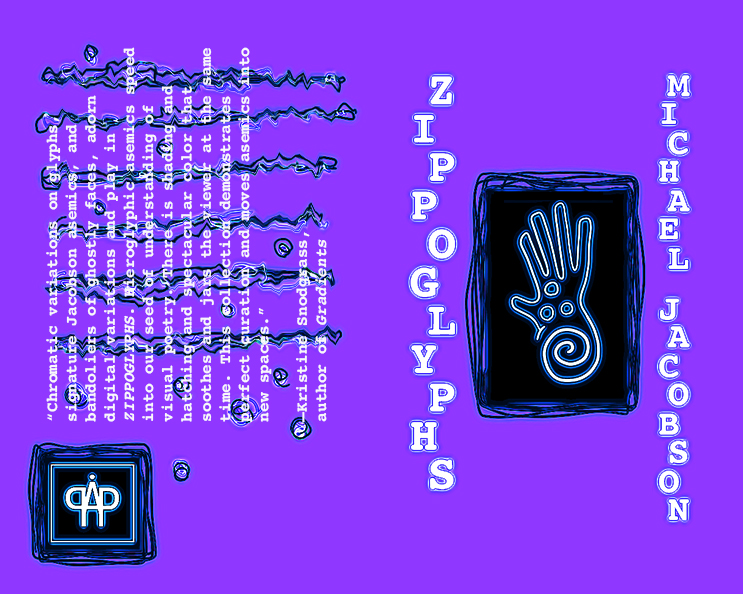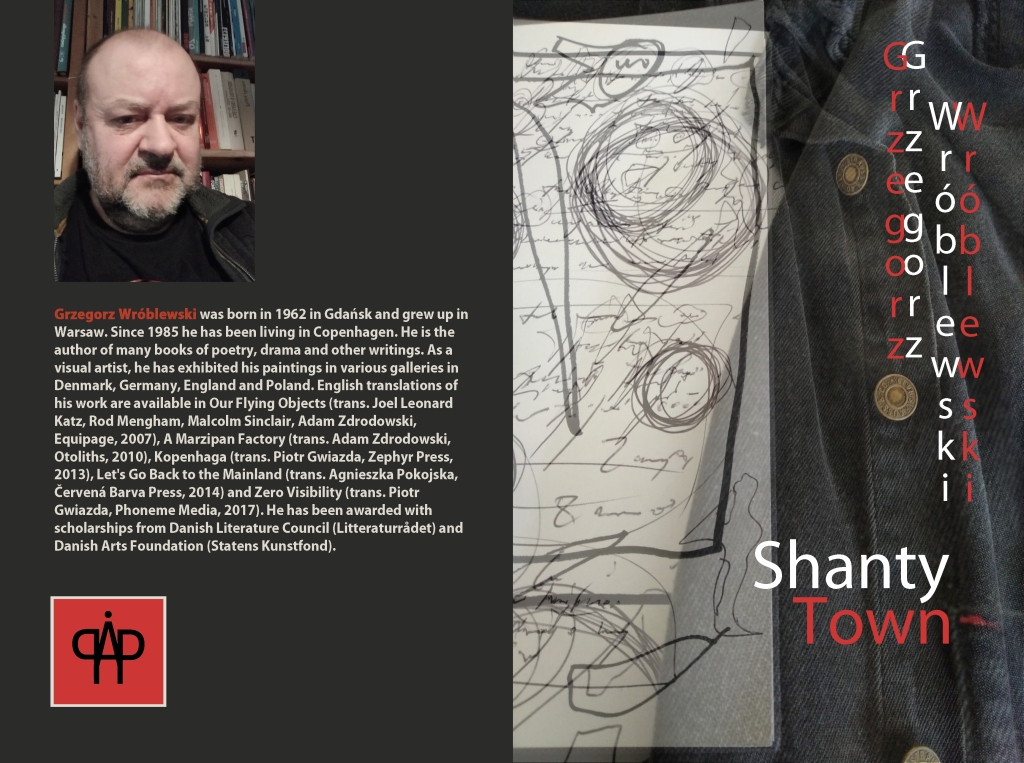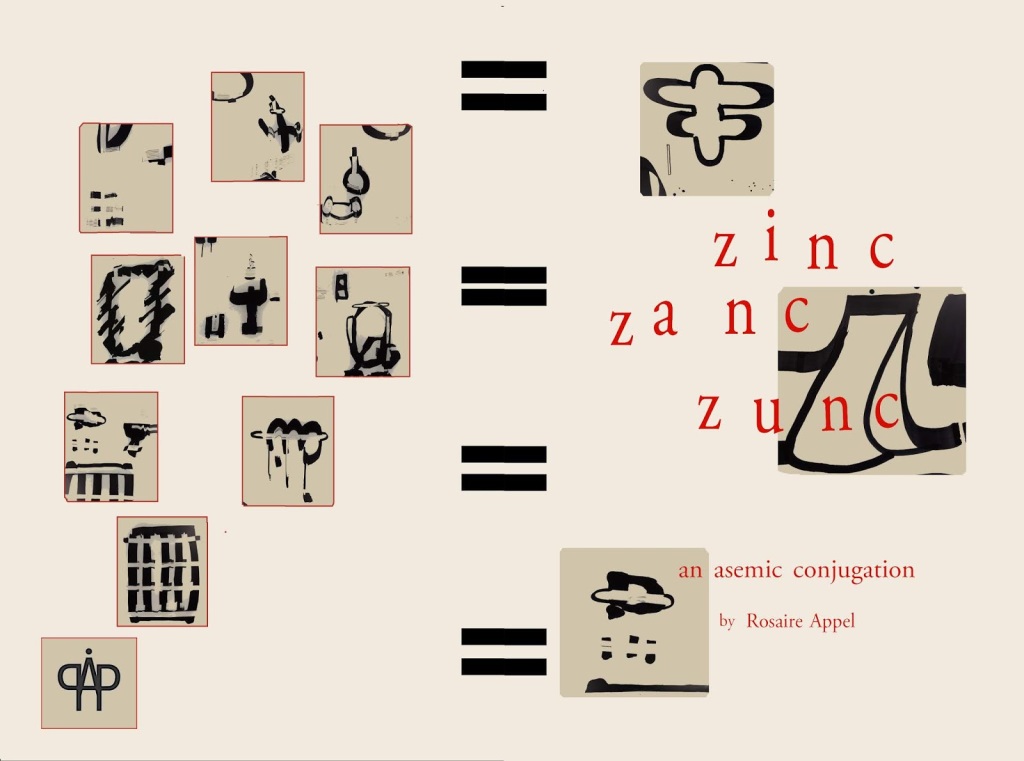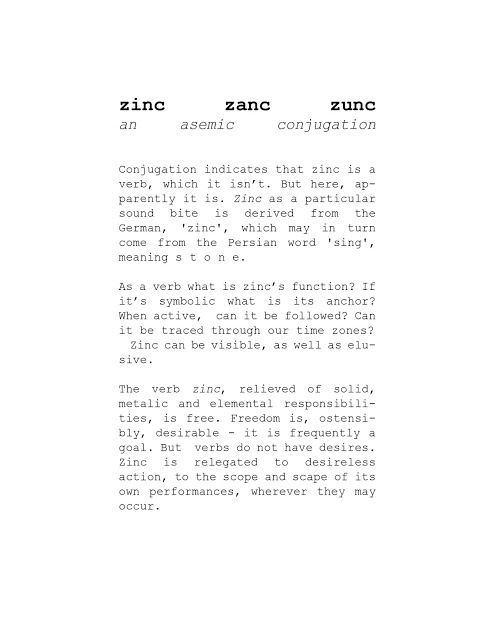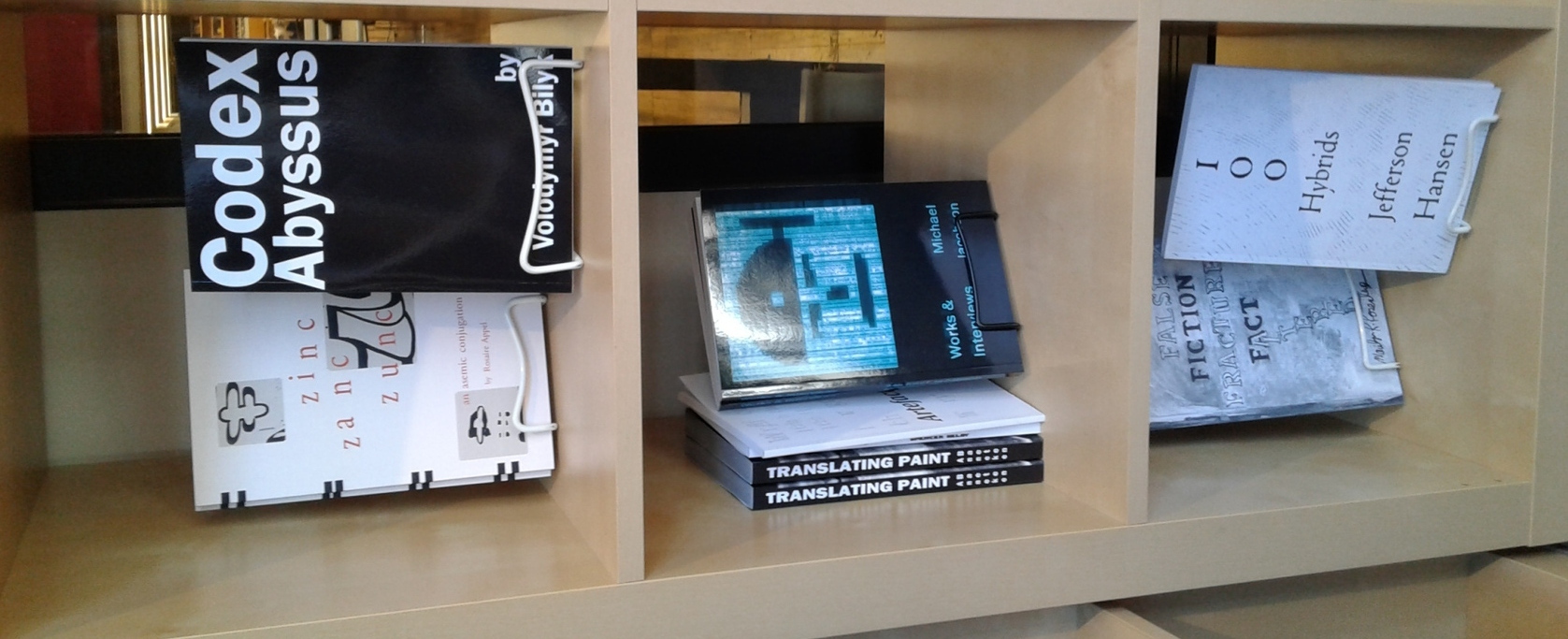
A Book Publisher of Asemic Writing & Beyond
Click on the book covers for more information and here to purchase the title(s) at Amazon.
Available Now @ Amazon!
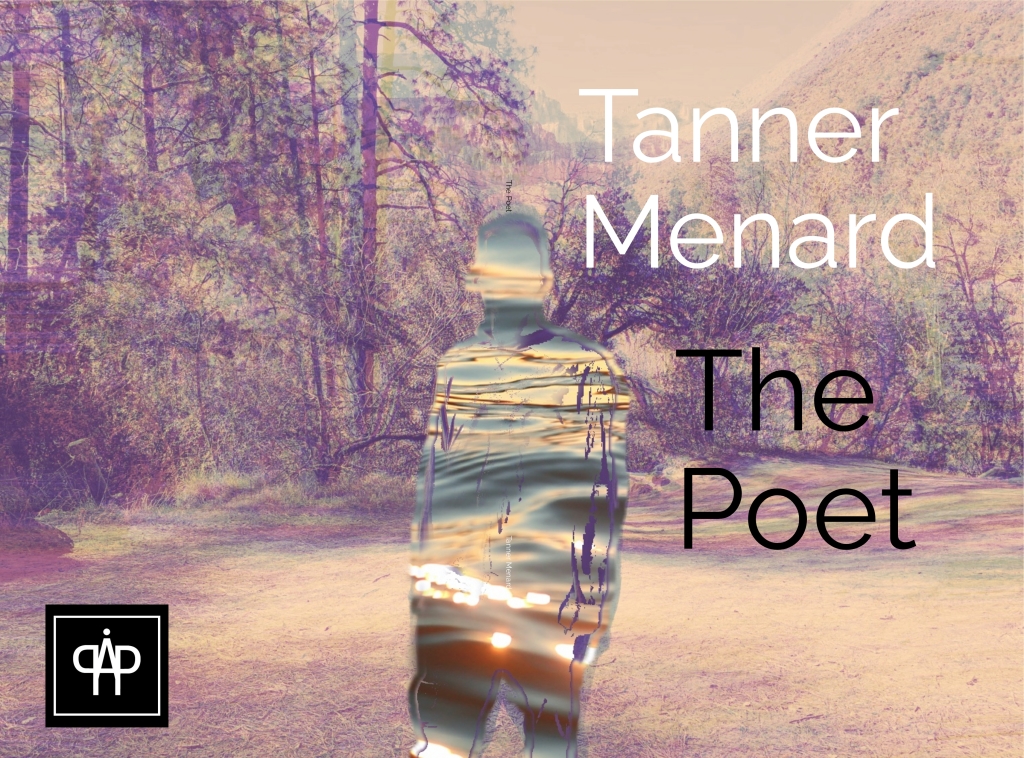
Available Now!
Gradients
by Kristine Snodgrass
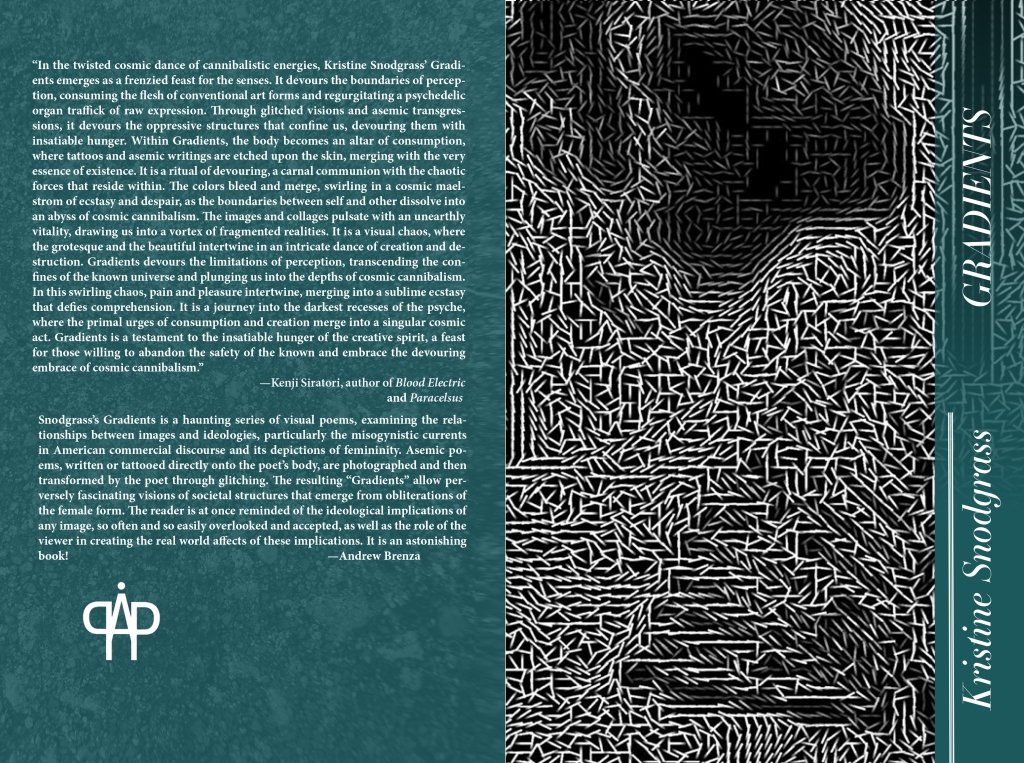
Available Now!
l’nguajamm’r
by Mike Di Tommaso
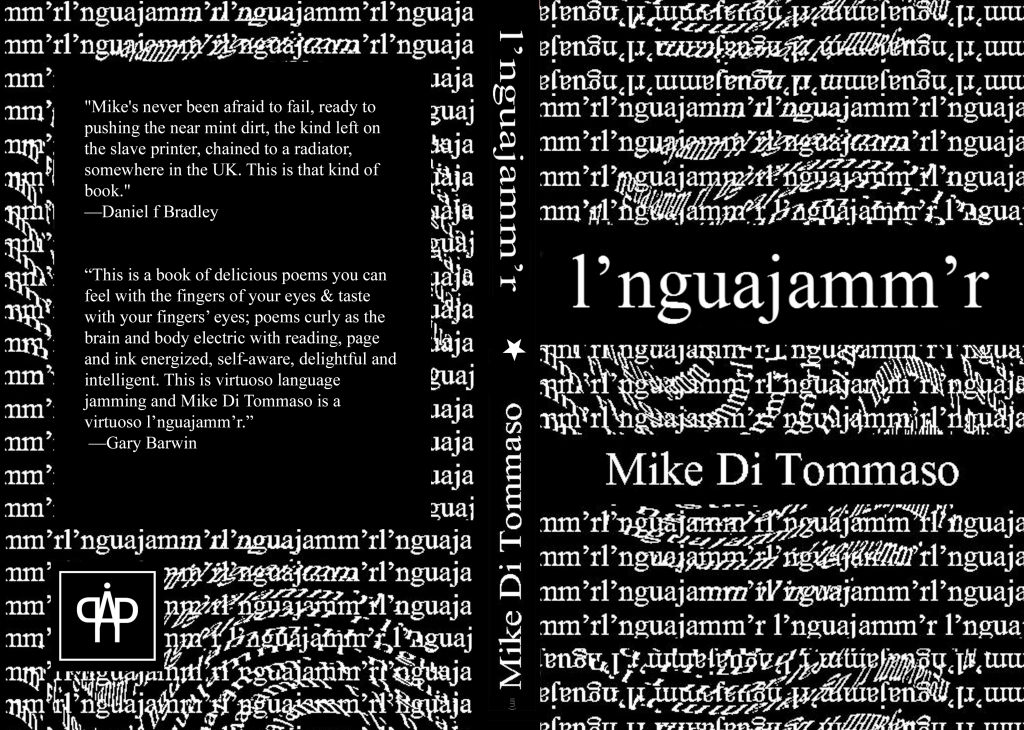
ZIPPOGLYPHS
by Michael Jacobson
id est: neo scribalist asemic expressionism
by Michael Jacobson
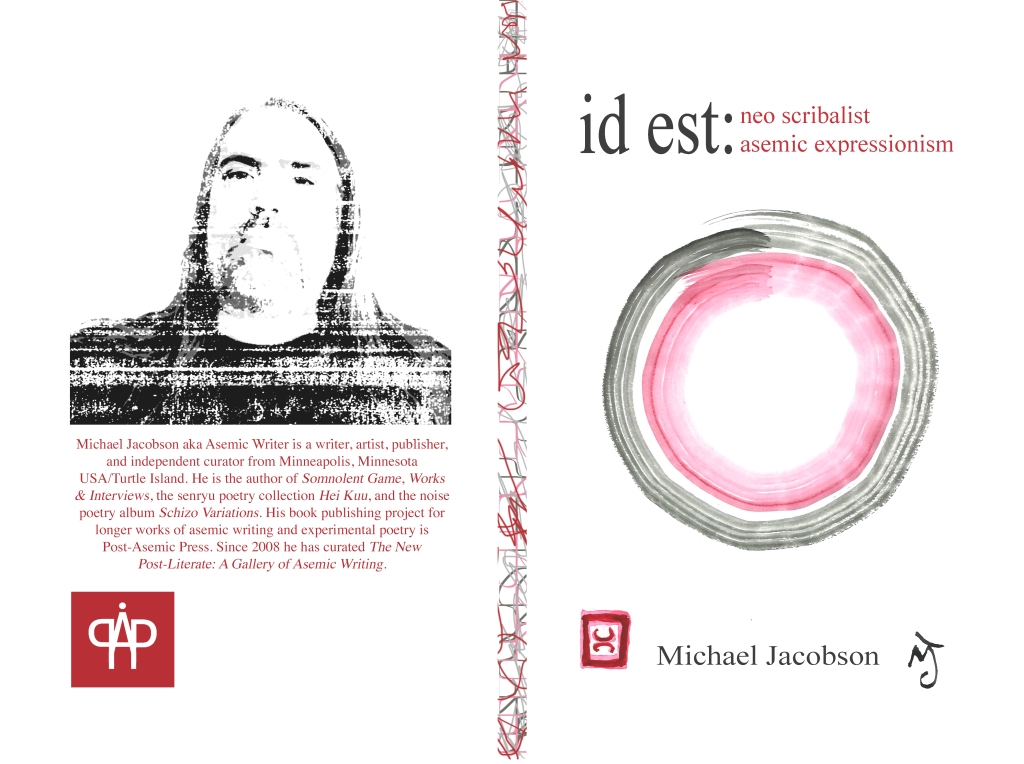
The Figments Are Here
by Jefferson Hansen
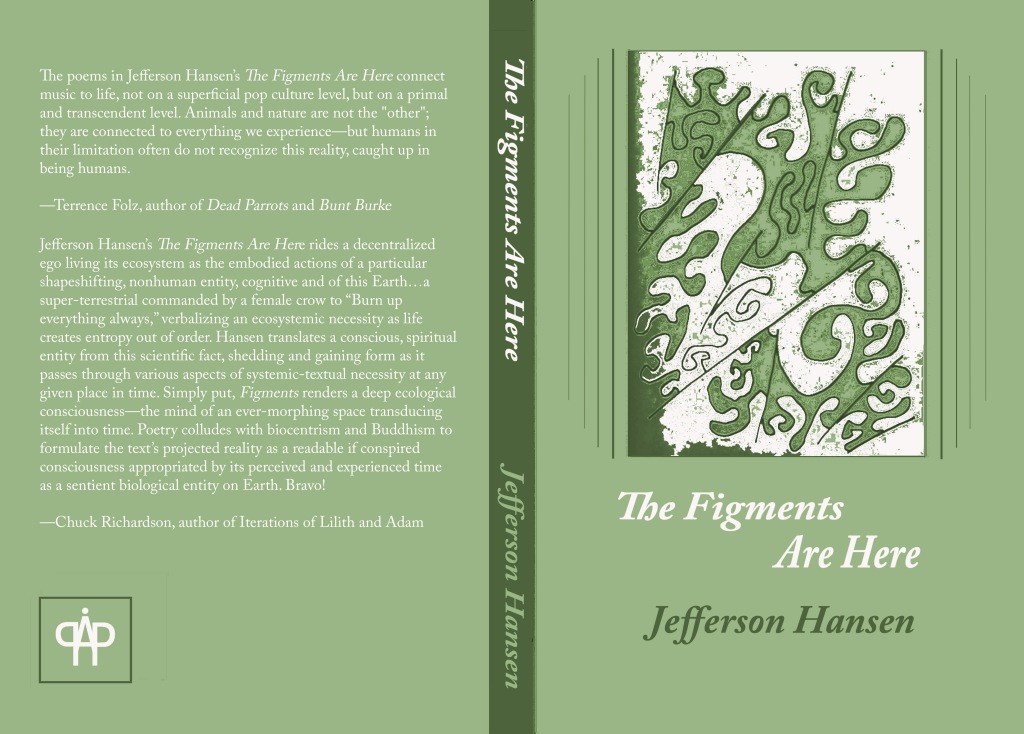
Typo Poem
by Michael Betancourt
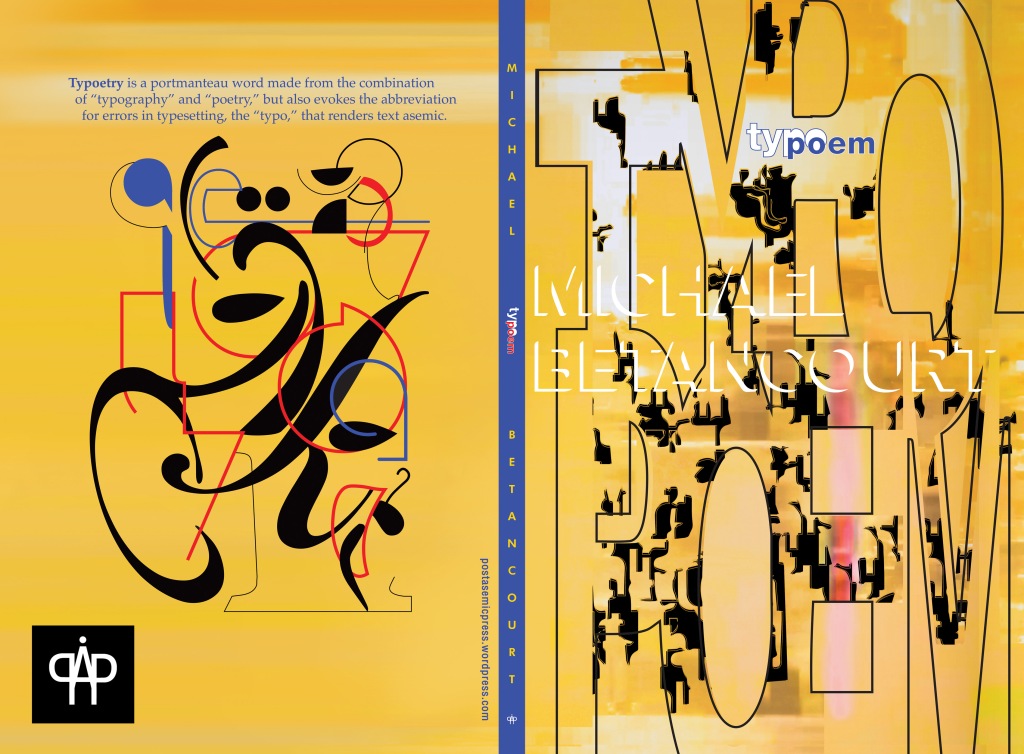
Betancourt’s typoems are reminiscent of many ideas in asemic language, Wildstyle, Cubism. Each and every work is layered and architectural warm, and also filled with humanitarian fragmentation that allows the imagination to move through these spaces.
— José Parlá, artist
Betancourt’s elegant asemic compositions, spatially ambiguous and graphically complex, are deceptively lucid at first glance. But these works hover in an indeterminate space, as if waiting to be collapsed through the perception of the viewer into an either/or resolution of il/legibility. Instead, the poems refuse to become fixed and thus sustain an ongoing provocation.
— Johanna Drucker, writer, artist, and scholar
in ghostly onehead by J. D. Nelson
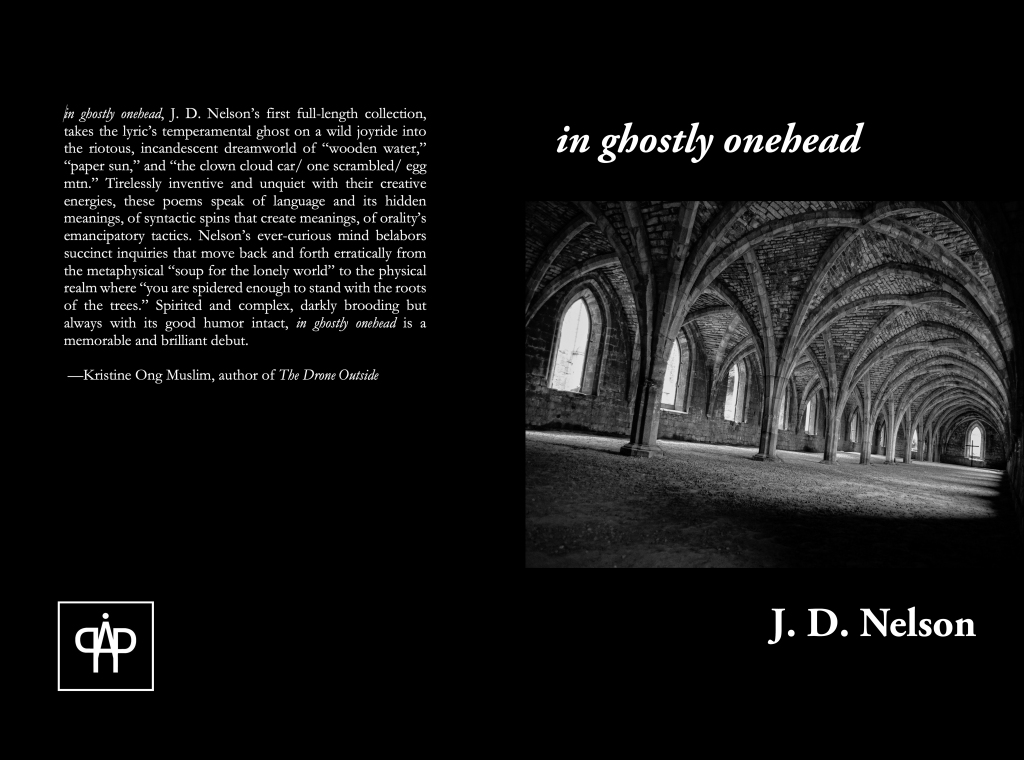
Possible Gardens by Jaap Blonk
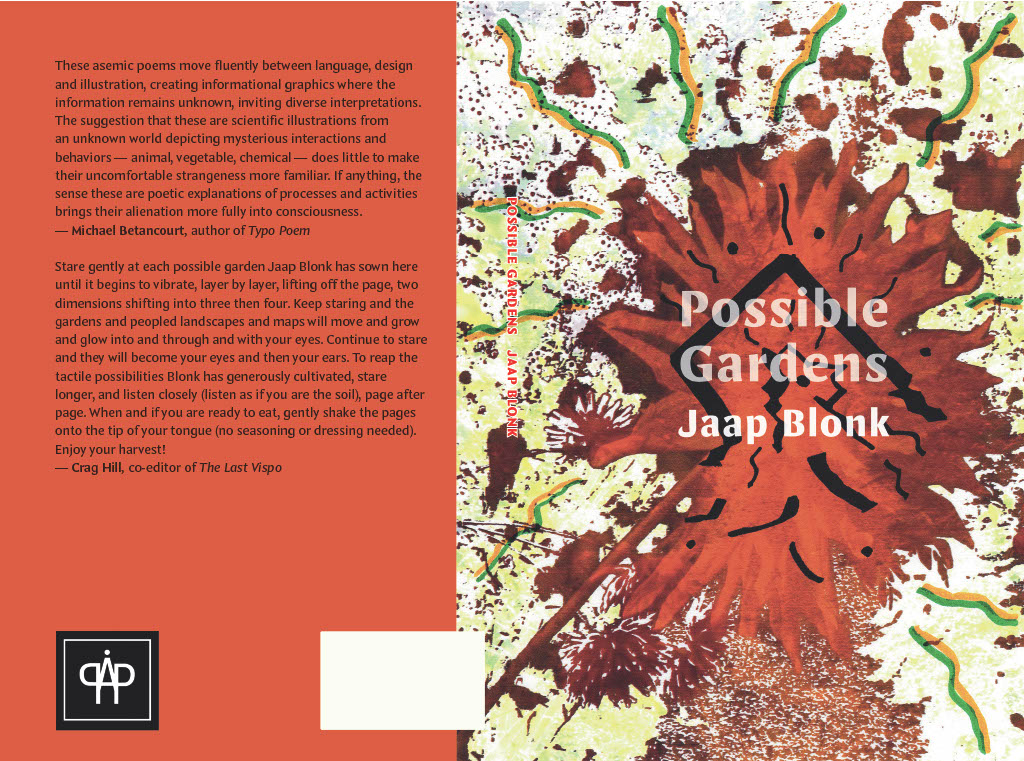
Shanty Town
by Grzegorz Wróblewski
Shanty Town packs a powerful punch. It stakes you straight through the heart and throws you overboard, only to next moment toss you a life buoy. It’s Grzegorz Wroblewski’s opus magnum, in which he brought together the heart and the mind on a whole new level. I see a world that worries him but nonetheless he manages to draw pure beauty from it. Somewhere in between, a fragile hope for salvation emerges. His own and ours.
– Karina Obara
Rough, unkept, spontaneous and free, Grzegorz Wróblewski’s Shanty Town depicts a blurry world of post-literate indecipherability. With coarsely drawn shapes imposed upon a chaos of asemic writing, this collection is built from the rubble of uncomfortable truths. A triumph of bold writing.
— Dave Read
Somnolent Game
by Michael Jacobson
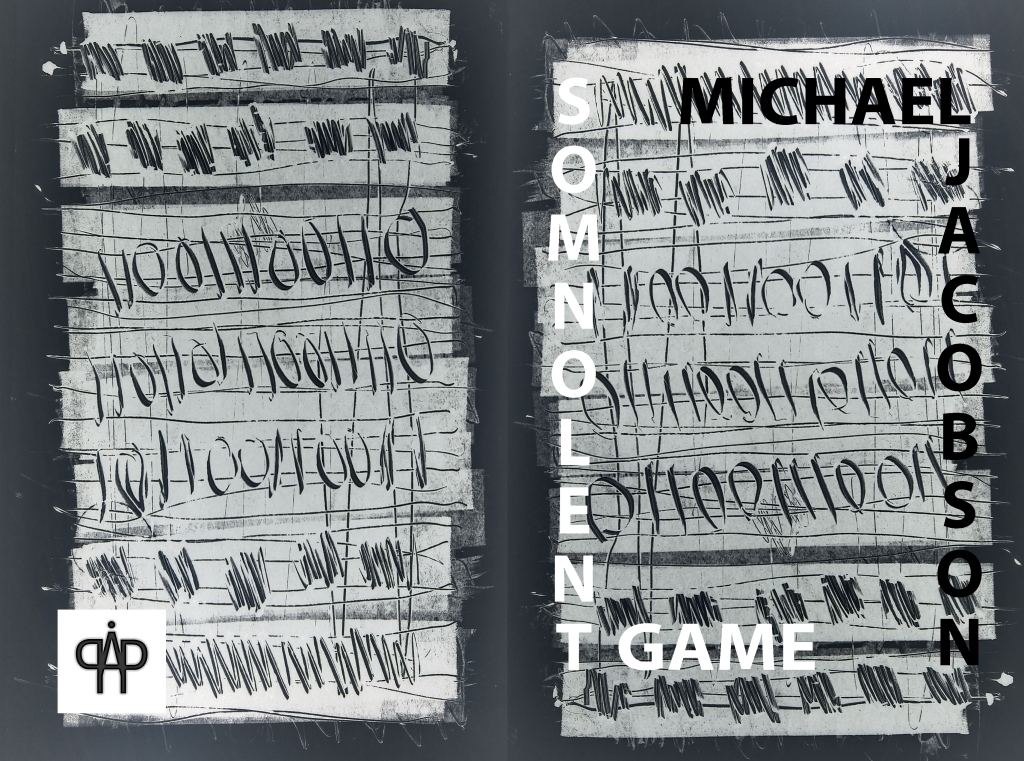
intimate h&s by Karl Kempton
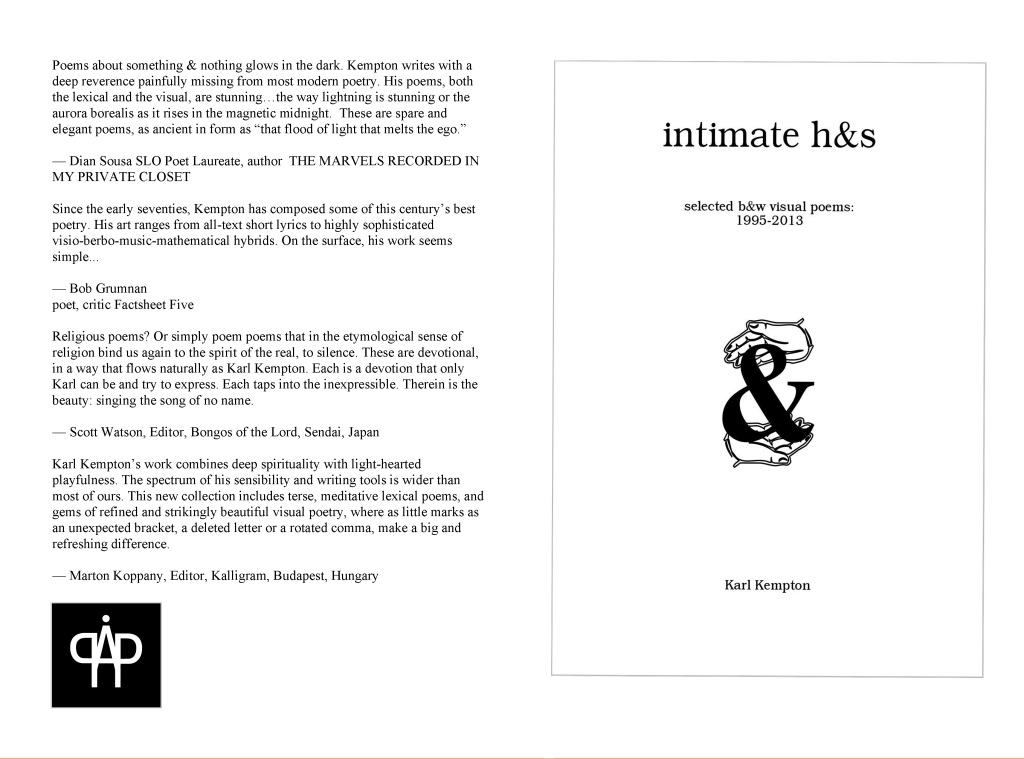
Unwritings by Laura Ortiz
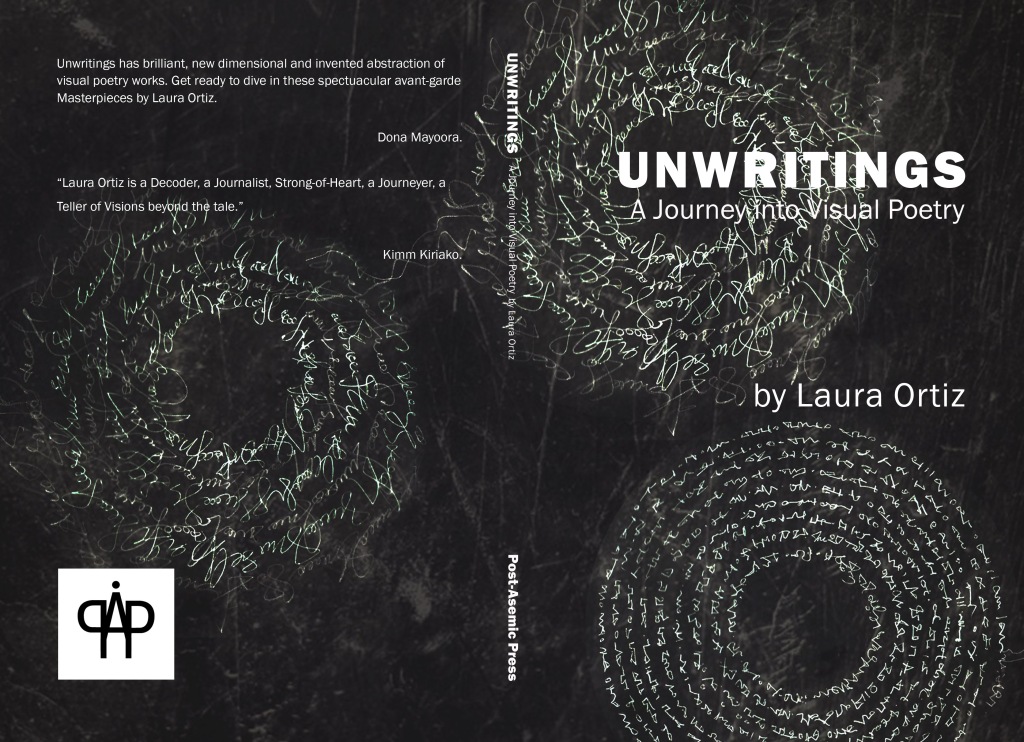
Glyphs of Uncertain Meaning
by Tim Gaze
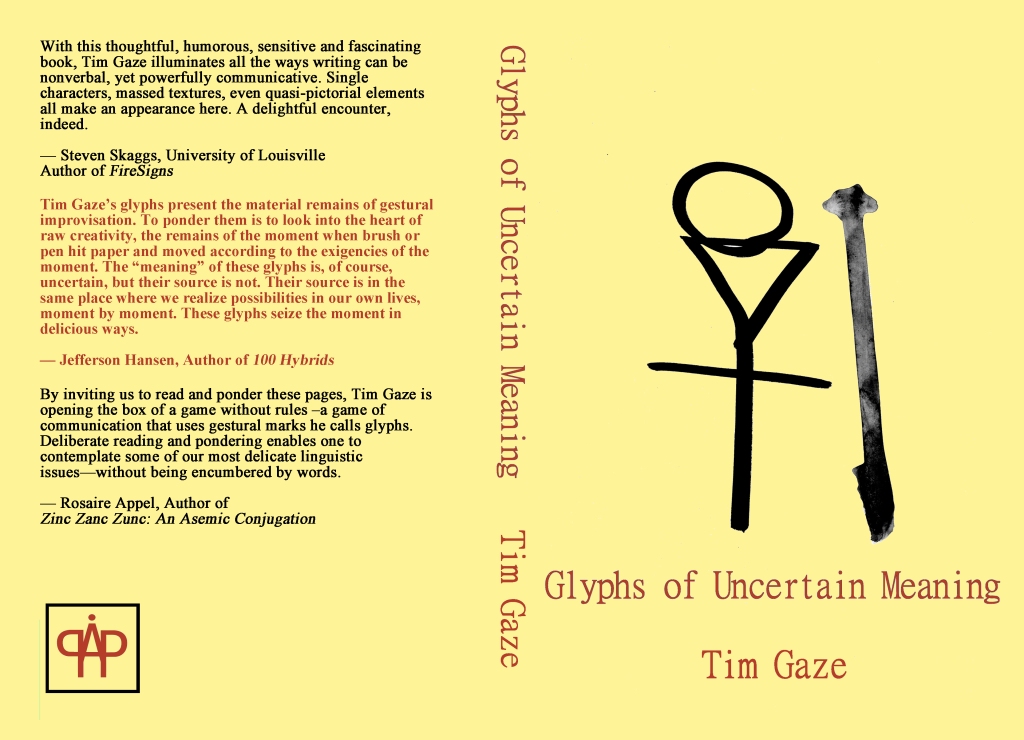
“Tim Gaze’s glyphs present the material remains of gestural improvisation. To ponder them is to look into the heart of raw creativity, the remains of the moment when brush or pen hit paper and moved according to the exigencies of the moment. The “meaning” of these glyphs is, of course, uncertain, but their source is not. Their source is in the same place where we realize possibilities in our own lives, moment by moment. These glyphs seize the moment in delicious ways.”
— Jefferson Hansen, Author of 100 Hybrids
“With this thoughtful, humorous, sensitive and fascinating book, Tim Gaze illuminates all the ways writing can be nonverbal, yet powerfully communicative. Single characters, massed textures, even quasi-pictorial elements all make an appearance here. A delightful encounter, indeed.”
— Steven Skaggs, University of Louisville, Author of FireSigns
“By inviting us to read and ponder these pages, Tim Gaze is opening the box of a game without rules –a game of communication that uses gestural marks he calls glyphs. Deliberate reading and pondering enables one to contemplate some of our most delicate linguistic issues — without being encumbered by words.”
— Rosaire Appel, Author of
GLITCHASEMICS by Marco Giovenale
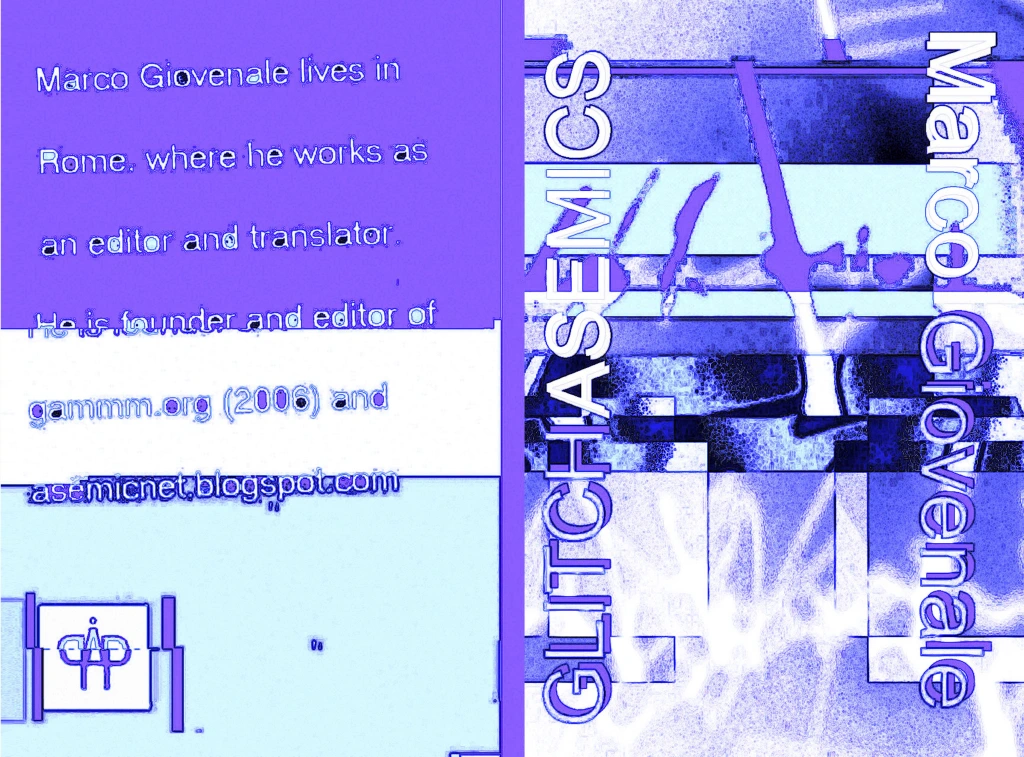
“Marco Giovenale pens poems that are truly intersectional, flickering on the nexus of several technologies including the hand, the computer, the camera, the book, and the xerox machine. Riddled with exacting error, they straddle the visual and the literary, the result of which is an extraordinary series of poems that are at once readable and lookable, both rigorous and serendipitous. Finalmente, parole in libertà!”
— Kenneth Goldsmith, curator and poet at UbuWeb
“Imagetext, glitchasemics, New Aesthetic, dirty media — call it what you will. This isn’t so much a book as it is a pop-up exhibition of literary malware that just may corrupt you too and you may not even know it.”
— Mark Amerika, author of remixthebook
“Monet said “To see, we must forget the name of the thing we are looking at.” I say some of my favorite poets are writing what generally isn’t recognized as even being poetry. Or even writing, in some cases. We’re getting there.”
— Jim Andrews, visual poet at Vispo.com
Code Poems 2010-2019
by Francesco Aprile
This book is a collection of “Code poems” that the author wrote between 2010 and 2019. He used different languages: pseudocode, Html with Javascript, Css, Php and Laravel, found code, command-line executions and git, errors log from Katalon, Mvn and Katalium. The recent history of writing provides a large part of the context for the reception of the information technology in literature. After a high school diploma about information technology, the author studied Science of Philosophy. During degree course, he matured the idea to work on relations between code and poetry. His first research in this field takes the name of “Poetic algorithm” (2010). With his first poetic algorithm, written in pseudocode, he won in 2016 the Source Code Poetry Challenge in “Most artistic” category. Code poems are cracks in the technical workflow, a poetic manumission in a language that is stranger for the poetry. Codes reveal the differential state of themselves as writing and poem, but these are always codes.
“Aprile is the Jeff Wall of techno-debris. His poems are short circuits,cracks in a technical workflow, hidden in plain sight inside a cityscape of stack traces.”
—Nick Pelling, blogger at Cipher Mysteries
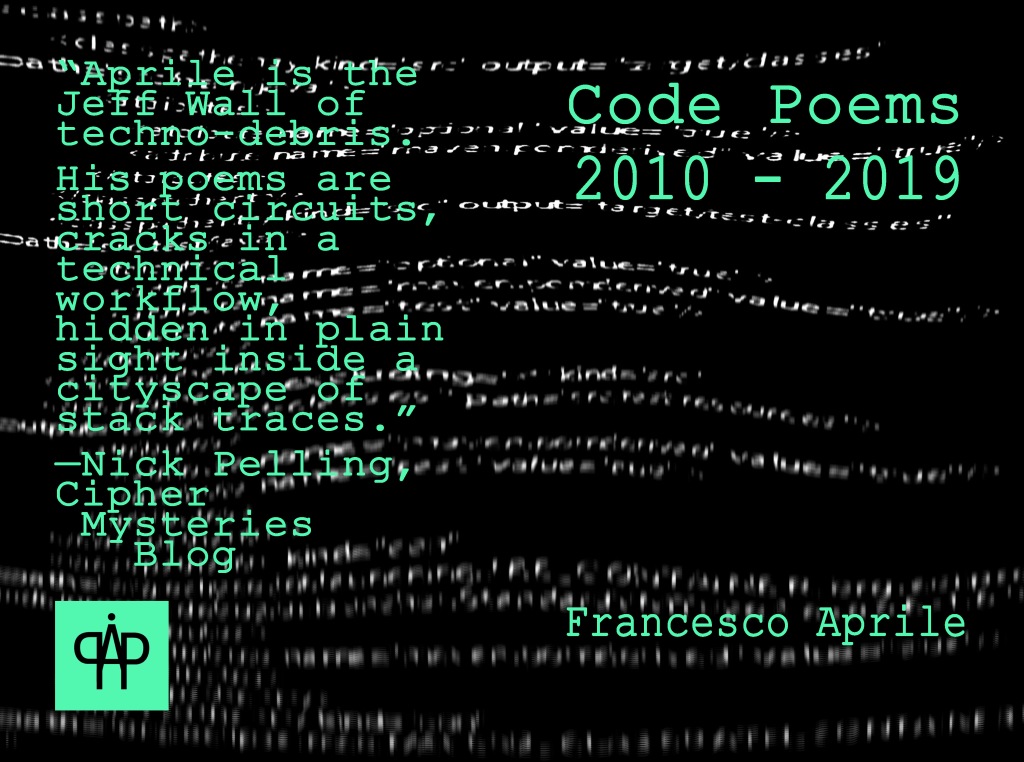
Hei Kuu by Michael Jacobson
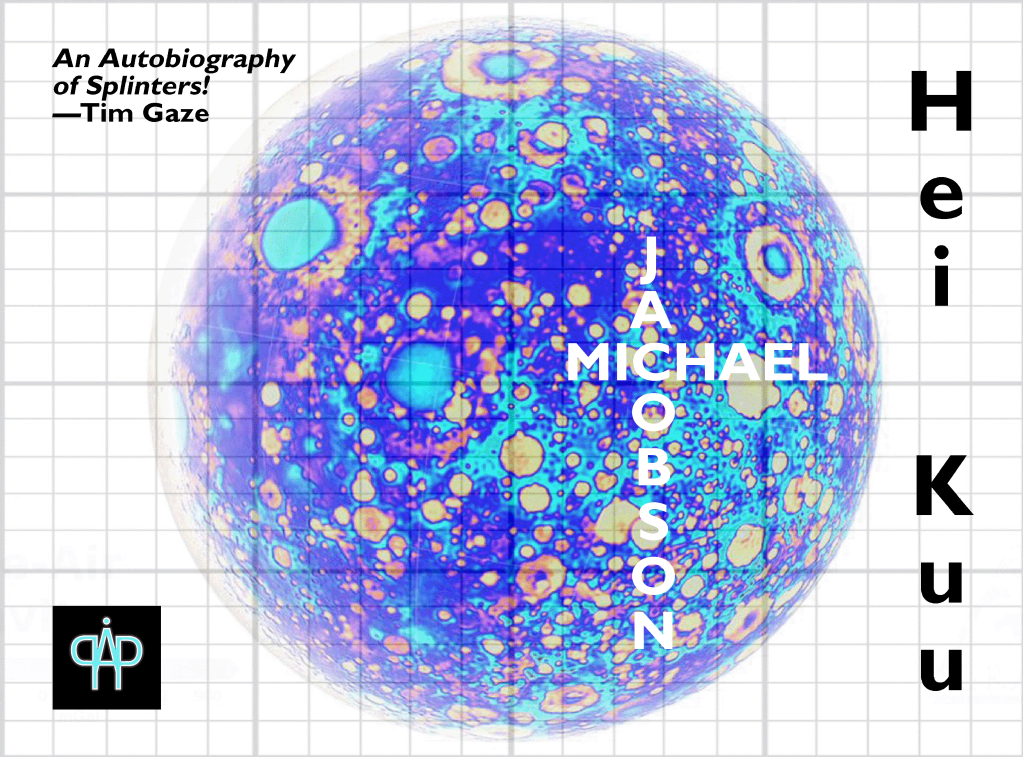
“Hei Kuu means “Hello Moon” in Suomi (Finnish). These are the 409-senryu, quasi-haiku, sacred-profane, ribald-punk, experimental-illness, schizo-affective, lunatic-lunar, computer-telepathic, anarchic-autobiographic, noita-divining, agnostic-confessional, poem-stories behind my wild western asemic writing life.”
—Michael Jacobson, author of Works & Interviews
“An autobiography of splinters.”
—Tim Gaze, Publisher at Asemic Magazine
Magazine: The Cut-Up Asemics
by Scott Helmes
In Magazine, there is poise; there is intention. Letters form openings, letters form arrows into openings. There is sexual heat, there is calm, there is clarity. There are lacey places like thin branches that form something together. Going deeply into the book, the images turn block-like, with greater conformance to solid letters. Some of the forms as humanoids resist each other or veer together. Angles are musical, even lamp like. Always there are edges. Always there are magnets and pulse-driven points of strength. Nothing is finished. Or everything is. Color is mildly allowed as suggested, but only that. A calligraphic zeal and respite all in one confirm a mind that plays precisely.
This is asemia at its purest. To the point that when I reach the author photo page, I reflexively begin to subtract flecks of the dark jacket and the word “Columbia.”
—Sheila E. Murphy, author of Underscore (with K.S. Ernst)
From among all the visual poets working today, Scott Helmes is the one most focused on the letter, especially the fragment thereof. His goal is not the word. His purpose is to examine the fractured letter in its typographic and calligraphic manifestations, to see what there is to understand in the atomization of written language, to uncover how the corners of individual letters can make us recall the language as a whole. In the poems in this collection, he merges his two major practices and fashions collage poems that mix the fluid rigidity of his favorite typographic forms with rough and painterly brushstrokes of ink, thus tying together the handmade forms of inking with the machine-made curves and slices of type. In this way, he reconnects two major practices in visual poetry, presenting us with two views of this world: the clean and the dirty—and the beauty of both.
—Geof Huth, author of 31 Pwoermds for 30 Years
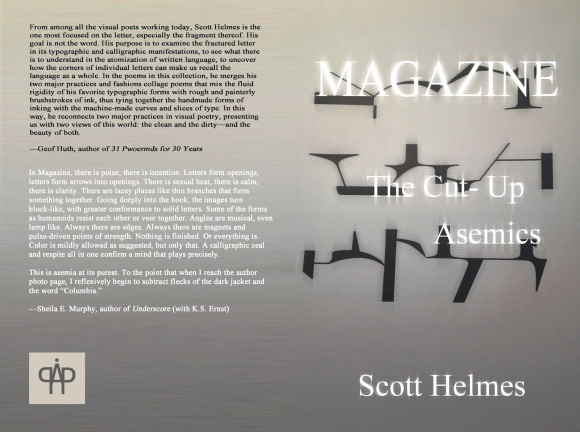
The Cecil Touchon Asemic Reader

A torrent of creative dynamism, The Cecil Touchon Asemic Reader comes at you in three waves: asemic overwriting of print, usually on antique pages; the elegant typographic collages for which Touchon is best known; and layered linear screens that seem to exist in a receding space. Through these variations, the book challenges us to rethink in depth our conceptions of surface, a thinking accompanied by wordless pleasure.
—Peter Schwenger, author of Asemic: The Art Of Writing
Touchon’s Asemic Reader is an important and inspiring book, and it calls to all schools of thought. The invitation here is to experience new dimensions of the present moment. Touchon’s captivating letter play and use of asemic writing makes him a true explorer of the invisible script.
—Sam Roxas-Chua 姚, author of Echolalia in Script (Orison Books),and Saying Your Name Three Times Underwater (Lithic Press)
The three layers/styles which build this book are as different as the reader or viewer’s reactions and observations which the layers imply & help create. The first series of works deals with an intriguing enigmatic silhouette, a shape and idea of time past. The calligraphic lines or typographic erasures or deleted music notes tell us intricate stories and talk to our perception according to the antiquity of the paper they’re written on. The second series shows broken letters, cut ones, like in a labyrinthine re-/de-organization of a stray alphabet of imagination. These well known and highly appreciated works by Cecil Touchon proudly belong to a tradition one can maybe connect to the names of Adriano Spatola and Edwin Schlossberg. A third little series introduces the viewer to an even wider range of codes, involving abstract movements of curls, curved signs, naturally evolving from the previous pages, as to mark a fascinating link between the fragmented alphabet letters and numbers, and a liquid set of traces impossible to grasp, yet still grasping our eyes.
—Marco Giovenale, author of GLITCHASEMICS
False Fiction Fractured Fact Altered
by Marilyn R. Rosenberg
A dynamic and liberating journey that takes us far beyond the neat and disciplined ranks of book typography into the unknown.
—Simon Morley, author of Seven Keys to Modern Art
I’ve known Marilyn R. Rosenberg’s work since the mid-80s and have had the honor of publishing her work as an issue of the visual poetry magazine Xerolage. In the era of fact facts and fake fakes these gestures of pen, pencil and brush expose the pre-cognitive gestures of a mind always moving thru a landscape populated by the enigmas of language yet to be understood. We open the notebook to remember, to project, to learn how to think again. The never-ending story never ends, or so we are led to believe. Believe in the marks your hand makes when no one is watching. They will never lie.
—mIEKAL aND, poet and publisher at Xexoxial Editions
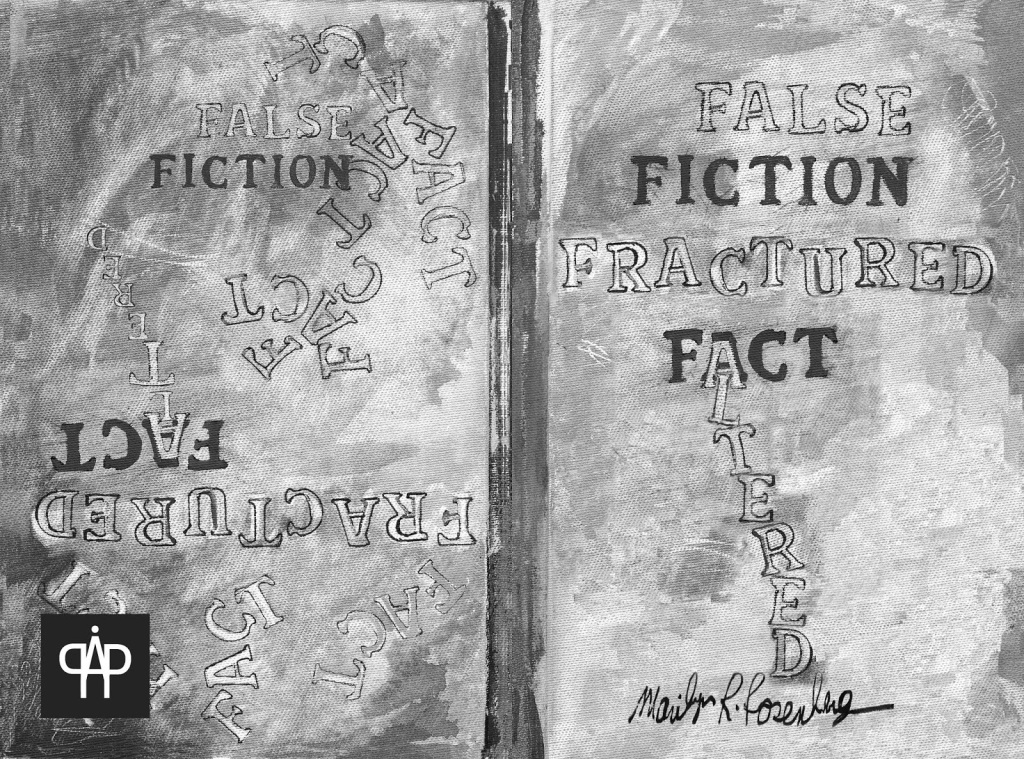
100 Hybrids
by Jefferson Hansen
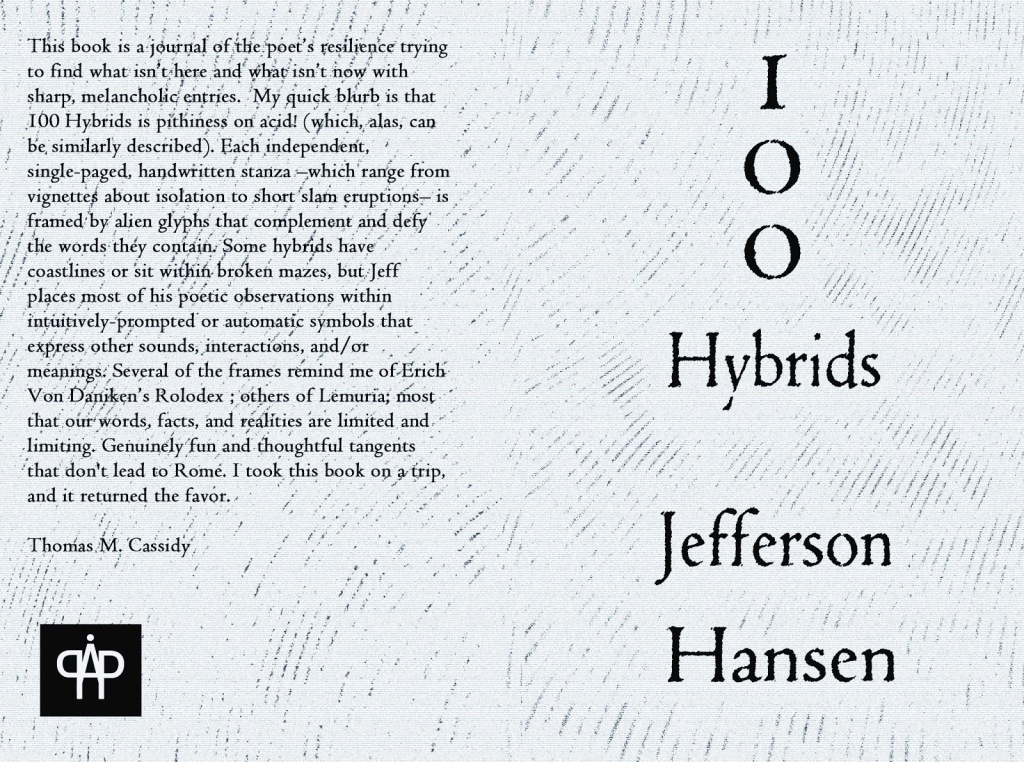
100 Hybrids offers a new poetic form: the combination of one stanza poems with handwritten asemic writing. While the poems explore issues of surveillance, artificial intelligence, social isolation, and magical realism, the asemic writing surrounding them plays off and sometimes against the poems. They often feature small, seeming “symbols” that proliferate meanings in a playful way. Other times the asemic writing looks like mazes or tight, layered non-writing. 100 Hybrids brings the primal, prelinguistic gestures of writing, the asemic, into vibrant and complicated interactions with poetry.
—Author’s statement
“This book is a journal of the poet’s resilience trying to find what isn’t here and what isn’t now with sharp, melancholic entries. My quick blurb is that 100 Hybrids is pithiness on acid! (which, alas, can be similarly described). Each independent, single-paged, handwritten stanza –which range from vignettes about isolation to short slam eruptions– is framed by alien glyphs that complement and defy the words they contain. Some hybrids have coastlines or sit within broken mazes, but Jeff places most of his poetic observations within intuitively-prompted or automatic symbols that express other sounds, interactions, and/or meanings. Several of the frames remind me of Erich Von Daniken’s Rolodex ; others of Lemuria; most that our words, facts, and realities are limited and limiting. Genuinely fun and thoughtful tangents that don’t lead to Rome. I took this book on a trip, and it returned the favor.”
—Thomas M. Cassidy
Artefacts by O Mayeux
In January 2017, O Mayeux wrote a computer program to dismantle all the poetry he has ever written, to tear it apart at its seams, to stitch its syntax into itself. What remains are these Artefacts, a cycle of asemic poetry. The abstract erotic narrative threaded through these poems is a delicate lament for the fragility of semantics, a tale of how we all remain unreadable to each other.
— Author’s statement
“Mayeux here takes the bits and pieces, the scraps and refuse of language, the smallest particles, and re-knits them into a unspeakable song, Language clamors and yawps, mutters and sighs a new poetry, a choir of difference, a harmony of letterforms.”
— derek beaulieu, author of Please, No More Poetry: The Poetry of derek beaulieu
‘Through disappointment comes clarity. From clarity comes conviction. And thus, from conviction, arises opacity, again, inescapable, overlapping, murky. This beautiful work, Artefacts, is a testament to life, through poetry, the way it actually is. Broken, eclipsing itself, beautiful, made of older pieces, physical, disfigured. Showing there can be no real clarity in language art, just a pristine fracture.’
— SJ Fowler, Poem Brut Editor at 3:AM Magazine

Translating Paint
by Anneke Baeten
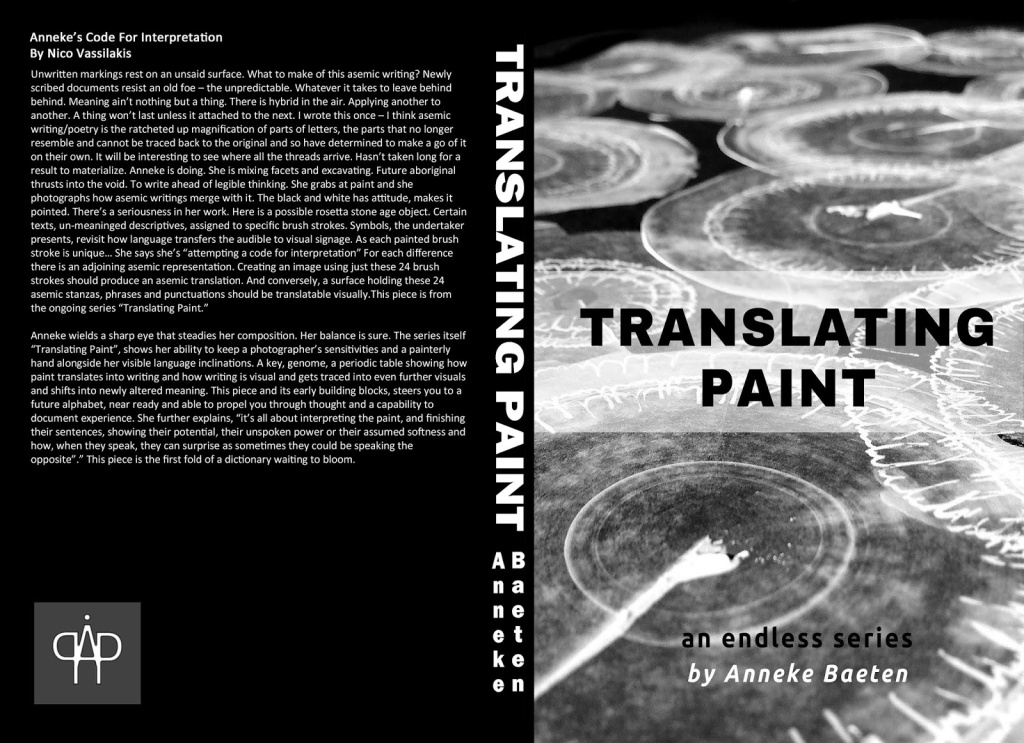
“Attempting a Code for Interpretation”. This is how Translating Paint starts! In the beginning there are 24 brush strokes. They are possibly a clue to the process of asemic translation for the work that follows this one mysterious page. Translating Paint is an ongoing series of asemic work that represents language, conversations, decoding, dialogues, and sometimes a process of finishing sentences with paint. This series shows the potential of discourse with paint, with its strokes, scrapings and its endless forms. This work meanders through a series of creative processes – from drawing the paint strokes, to creating the writing around and in the shapes, assigning a title to the work and finally photographing the work from the best possible angle to provide the viewer a possible close-up perspective on the nature of the dialogue.
As the author regularly continues work on this series, the product so far is this collection over 200 pages. Leafing through this universe, the viewer is invited to create their own decoding of the pieces or to simply enjoy the aesthetics. It will be easy to get lost in the black bleed pages where the white asemic work appears as if it emerges from a quiet and dark universe that has no context or meaning. Finally, there is the final stage in the process – the viewer’s interpretation.
—Anneke Baeten, Ferrets In My Head
Codex Abyssus
by Volodymyr Bilyk
“Codex Abyssus is a work like no other. This new edition adds a chapter of 43 new pages which are less chaotic than the original first edition of the book, but resonate with the creative obsession of a writer’s living artistic cells. Codex Abyssus is a conversation about the liberation and constraint of encasement. These abstract calligraphic boxes are meant to be lived in, given away as presents, or escaped from. Reading the squares of Volodymyr’s infinite design and imaginative potential, one is first drawn in by the familiarity of the handwritten gestures, and then by the asemic signs with their unique quadrangle symbolism. It is a work that ends with elastic technique, and the simple pleasant low-tech approach of a pen and paper manuscript. It is an enjoyable work because it contrasts and collaborates with the electronic overload and flood of information on the Internet. Codex Abyssus is a document of human scrawls in their purest unfiltered creative state.”
—Michael Jacobson, Publisher at Post-Asemic Press
“An epic of intricate maniacal boxes encoded as mischief.”
—Amanda Earl, Publisher at AngelHousePress
“Zigzagging map-like lines. Thick and thin lines alternating. Shaded triangles emerg- ing from one side of the square. Taken together, these little squares add up to a surfeit of images, an impossible-to-take-in totality. To read this book is to get lost into its detailing, not to come to some sort of vision. It literally is its details.”
—Jefferson Hansen, in Rain Taxi
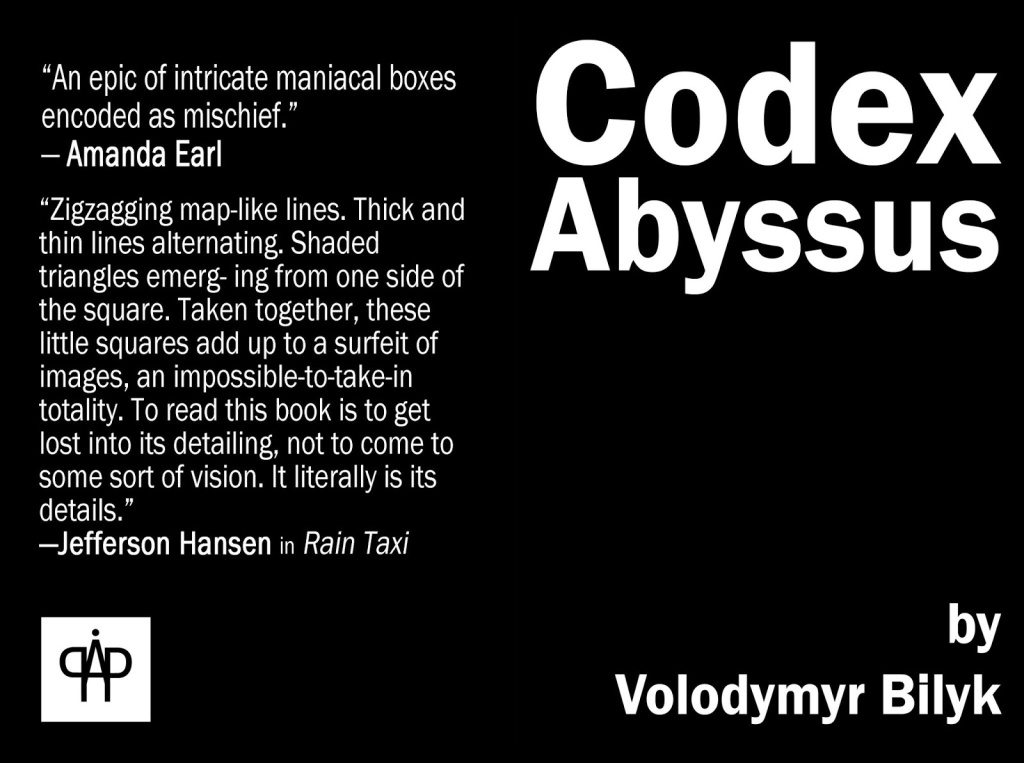
Zinc Zanc Zunc: An Asemic Conjugation
by Rosaire Appel
Unknown Message
by Spencer Selby
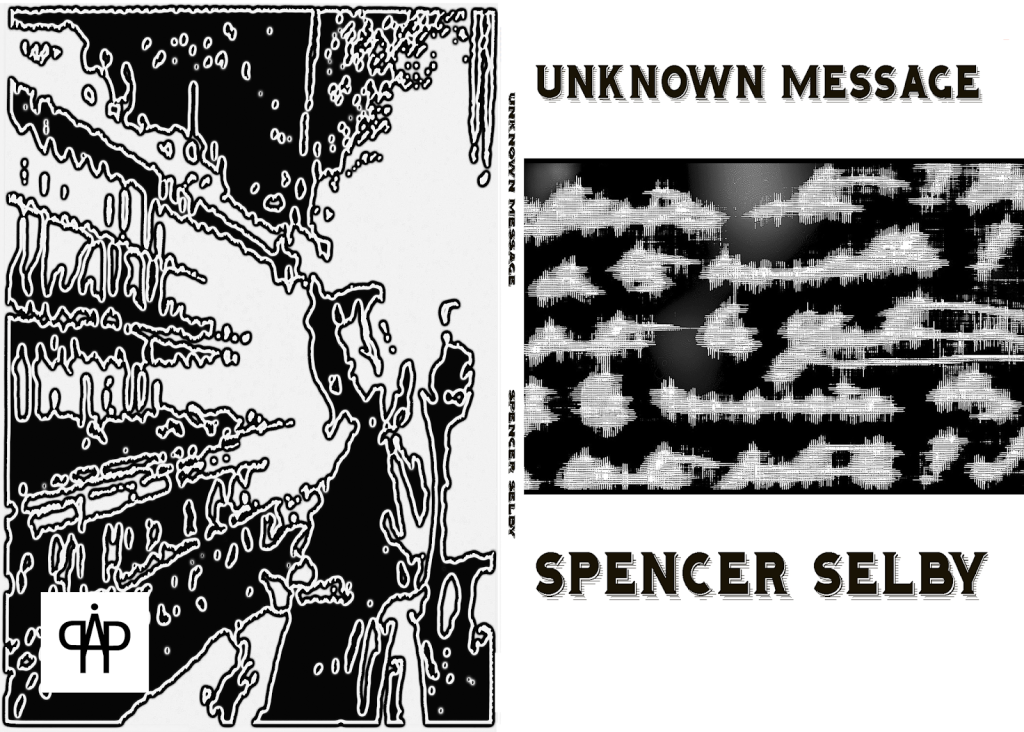
“Here are some Petri dishes, each full of an alternative writing culture or sample of writing from an alternative civilization. Some of this writing appears to have been yanked and stretched, as if it had been written on a sheet of elastic material. Other pages resemble maps, diagrams, digital crystals, tattoo designs or ancient pictographs. Noise or wind or smeariness is a common feature. Throughout this work, the third dimension seems to be trying to push itself forward from the flat paper surface. There’s a human presence hiding on one page, perhaps the author hard at work. I suggest that this book contains a message from the future.”
—Tim Gaze
“The physical act of reading is altered here, it undergoes a shift. The challenge is to assess how a reader views and how the veiwer reads. A sentence carries information from one margin to the other. The line travels across the page. What happens between margins is open to interpretation, to some divine corruption. In UNKNOWN MESSAGE, Selby not only adjusts the content of the line and how it reaches a margin, but he takes alphabet to new visual potentials. Meaning is in the seeing meaning form new ways of seeing. These poems are derived from visual chromatin conveying the genetic material of a future language event. Again, the cycle of disintegration to renewal in visual language approaches. These asemic missives find you, are awaiting your attention.”
—Nico Vassilakis
“Fuzzy-wuzzy, cranky, cryptic, vibrant, prickly, deterritorialized, endearing… no, these are not names of Snow White’s avant-garde dwarves but just a few adjectives that adhere to the overwhelming variety of Spencer Selby’s asemic marvels. These textural, textilic surfaces invite engagement of the most tactile kind, but they can’t be touched except with our loving, delighted eyes. Poring over them is a wild ride into the possibilities of illumination and meaning. If Plato’s cave were the ideal rather than the simulacrum, its walls would feature these brilliant marvels. We are drawn toward these angelic morsels of signification, flickering sememes that reveal and conceal.”
—Maria Damon
Works & Interviews
by Michael Jacobson

Works & Interviews collects Michael Jacobson’s dynamic asemic writing and his thoughts on the current asemic movement in art and literature. Included in the book are his asemic “stories” The Giant’s Fence, Action Figures, A Headhunter’s Tale, PΩz, THAT: A Plan(et), and The Paranoia Machine. The text also contains 9 interviews he has given to various online journals over the years such as at Full of Crow, SCRIPTjr.nl, Samplekannon, Asymptote Journal, Slova, Twenty-Four Hours, David Allen Binder, 4 Questions with Marco Giovenale, and also includes a previously unpublished interview with Jacobson by poet and journalist Volodymyr Bilyk. Works & Interviews documents the evolution of an early 21st century artist, writer, and publisher who uses science fiction calligraphic scripts to explore the locus of manuscript art in relation to technology and internet culture.
Since 2008 Michael Jacobson has curated the influential blog/gallery The New Post-Literate: A Gallery Of Asemic Writing, and in 2017 he was a guest curator of the Minnesota Center for Book Arts exhibit Asemic Writing: Offline & In The Gallery, which was the first large-scale group exhibit of asemic writing in the United States. In 2013 he co-edited with Tim Gaze An Anthology Of Asemic Handwriting, which collected over one hundred asemic scribes from around the world and is the most definitive collection of asemic literature published so far. In 2017 he founded Post-Asemic Press to publish asemic writing, experimental literature, post-graffiti, abstract comics, visual poetry, Lettrisme, abstract calligraphy, etc. He currently lives in Minneapolis, is a father, an avid cyclist, and posts most of his asemics, art, and gif animation pohmz to his online ello studio @asemicwriter.
Contact
A list of Post-Asemic Press titles available at Amazon
postasemicpress@gmail.com
postasemicpress.blogspot.com
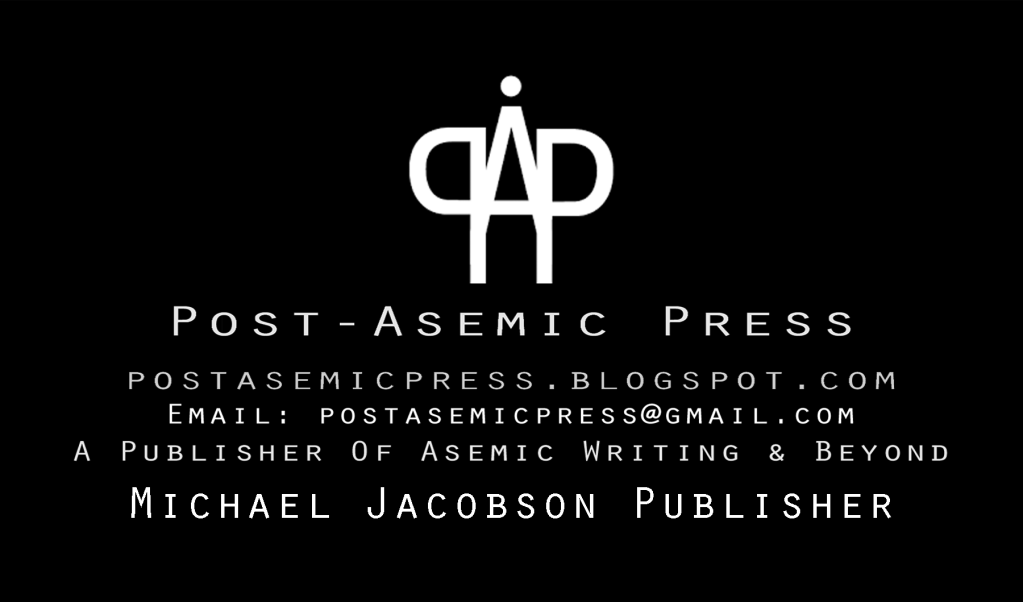
Send Us a Message
Copyright Post-Asemic Press – All rights reserved
